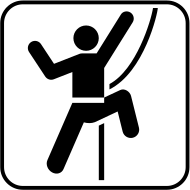Rope solo climbing
Appearance
This article needs additional citations for verification. (April 2012) |
| Part of a series on |
| Climbing |
|---|
 |
| Lists |
| Types of rock climbing |
| Types of mountaineering |
| Other types |
| Key actions |
| Key terms |
Roped solo climbing or rope soloing is a form of solo climbing without a climbing partner, but with the safety of rope protection.
Variations
- Roped solo free climbing refers to top roping on a fixed rope, a traditional (aka trad) climb, or a sport climb.
- Rope solo aiding involves fixing the rope to an anchor and connecting yourself to the free end with either knots or one of the various modern devices designed for roped soloing. Then the pitch is led as a standard aid pitch would be led. The process is identical to roped solo free climbing, but is usually much easier to manage.
- Simul solo aid is a speed climbing technique where two climbers aid climb at the same time on opposite ends of the same rope. While climbing they alternate between free, aid, soloing, and simul climbing depending on the situation.
Potential danger
Roped soloing is much less dangerous than free soloing but more dangerous than climbing with a partner. Significant modifications from partnered safety procedures are required. Also, in case of an accident, sometimes there is no one to go for help. It can also be tedious, as the climber must ascend each section of rock twice: once to add the next belay anchor, then again after descending to remove the previous one, traveling the route three times.
References
